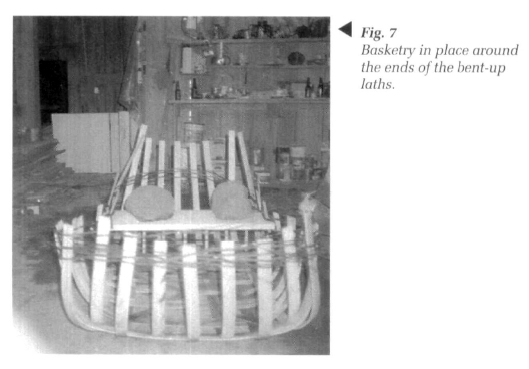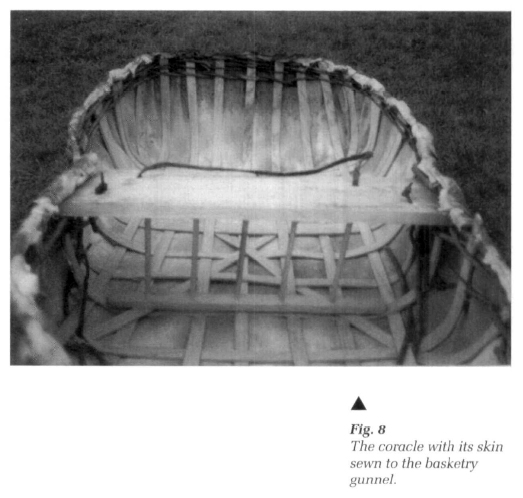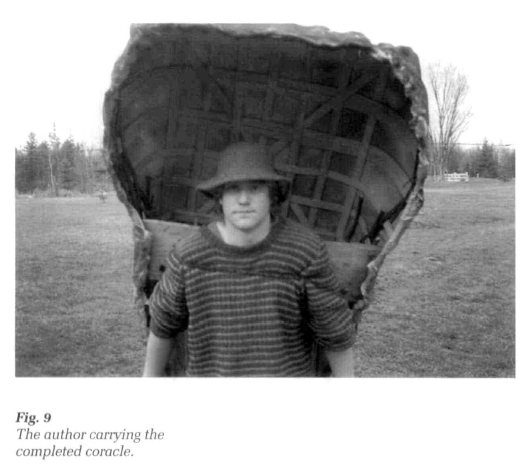Research Reports / Rapports de recherche
The Teifi Coracle
1 The term coracle denotes a variation on the ancient nautical theme of skin-covered wooden frames for use in relatively unchallenging waters. What sets the coracle apart from other vessels in this larger category are the characteristics of being light weight, round or oval in shape, and of featuring weaving as a technique for binding the elements of the frame together. Another defining feature is the use of these craft. They are almost never used for ocean-related activities but find their functional niche primarily as simple ferries or river fishing boats.
2 Examples of this type of craft can be found in Asia, Europe, and both North and South America. This widespread use may be partially attributed to the fact that they are extremely primitive in design, requiring almost no tools and only a single, or at least very few, hides and several pliable branches or saplings. The widespread availability of these materials, tool-less construction, and easy portability, surely account for their almost universal popularity. Furthermore, they were easy to use for simple tasks such as ferrying, and ideal for certain types of fishing.
3 Thus, to a certain extent, the coracle occupies an archetypal role in the context of skin-covered boats. It was from this first primitive form that modifications were made to suit local conditions. As a result there evolved some of the more intricate and specialized craft of this type, such as the Irish sea-going curragh or the umiaks of the Arctic dwelling peoples.
4 The coracle must not, however, be understood as merely a particularly unevolved form of this type of craft; the degree of specialization is a question of how much the boat is crucial to the day-to-day existence of those using it. Coracles tend to survive without evolving into more elaborate craft where they are employed only during part of the year, and then only for tasks upon which the social group is not dependent for their survival. For example, in Ireland the curragh, arguably the most complicated of all the skin boats, was extant alongside the Boyne coracle, each fulfilling a different use. The curragh developed because its users depended upon sea fishing for their survival.
5 It would appear that coracles have flourished mostly in inland cultures. This is perhaps a slightly ignoble boast for a boat to make, but nonetheless, it is a unique one. They have been used almost exclusively for ferrying and fishing on rivers. This form of craft can be found inland almost everywhere in the world, and there are many variations on the basic form, from the particular differences between coracles of different rivers in Wales to the vast difference between the tub-boats of Japan and the pelota of South America.
6 Culturally, coracles have been most closely associated with the British Isles. They are mentioned in historical and literary accounts from the time of the Roman conquest of Britain right up to this century. In the earlier descriptions, which are generally by foreign travellers, they are recorded as a curious cultural phenomenon. The Britons themselves scarcely mentioned their existence, no doubt because they were so familiar to them. However, with the advent of printing, and the consequent increase in publications, there are more frequent references. These references portray them as a normal part of British rural life and, as such, are to be found in works that describe rural scenes and activities of the time. For example, Andrew Marvell concludes in "Upon Appleton House:"
Their Leathern boats begin to hoist;
And, like the Antipodes in Shoes,
Have shod their Heads in their Canoos.
How Tortoise like, but not so slow.
These rational Amphibii go?
Let's in: for the dark Hemisphere
Does like one of them appear.1
7 Despite the increased familiarity in historical references during the last few centuries, we note a certain distancing of the English from the craft; a relegation of them to the Welsh and to the distant past. What had previously only constituted a curiosity worthy of record in the journals of foreigners to Britain became the case within Britain. This is curious because the records of them are generally not confined to Wales; they were used in Ireland, Scotland, and England. It is possible that the antiquity of the vessel made it somewhat inappropriate for inclusion as part of English culture since it connoted precisely the type of primitivism that the English so desperately tried to distance themselves from during their imperial project. For example, the Duke of Rutland describes them as a curiosity. He draws attention to his estrangement by comparing them to the canoes of the North American Indians, and by so doing, emphasizes the implication that these craft are culturally completely alien.
8 The "savages" of the countries into which Britain was expanding her empire in the nineteenth century had coracles. In India there were Kurnul and Tigari coracles, among others; in China there were many examples; and in North America was to be found the bull boat of the Plains Indians. It was perhaps not the wish of the British to draw attention to cultural similarities such as the coracle unless they could be said to be relics of a long gone age of a relatively uncivilized nature.
9 Unfortunately, this trend towards ignoring the coracle continued right into the latter stages of the nineteenth century. The ideas of progress that were inspired at the time of the industrial revolution were the most serious threat that the British coracle ever faced.
10 At the turn of this century, there was a definite resurgence of rurally based novels in Britain. This came about partly as an artistic reaction to the widening gulf between urban and rural societies. However popular these books may have been at the time, they would seem to have been temporarily passed over in favour of work that embodied wider themes that transcended the importance of setting. One would definitely expect to find reference, in the work of the Powys brothers or Dylan Thomas for example, to this cultural icon, but there is none. The literature of this type tends to focus on more abstract and universal themes. Unaided by popular recognition, die coracle drifted ever closer to extinction. It remained culturally unattended because it could not fulfil that era's need to translate rural life into situations that encapsulated the essence of British culture in a general way.
11 The survival of the coracle through these difficult transitional times attests to its unique efficiency as a fishing boat. This survival, however, has been extremely precarious. Coracles, until quite recently, were on the verge of sinking into history forever. In the last decade they have enjoyed a revival in both their numbers and their cultural significance. The oracle has been swept up in the continually rising wave of heritage conservation, this cultural wave having as its epicenter a reaction against the powerful homogenizing and shrinking effects of technology, and against its self-reflective culture. In the time of D. H. Lawrence, the coracle was too specific a symbol. In the time of the Mutant Turtles, this concrete and specific symbol is food for the culturally hungry.
12 The Welsh coracle now boasts its own society, and there seems to be a genuine sense that it should be preserved for its significance as well as for its usefulness. According to Dr. J. Geraint Evans, founder of the Coracle Society in Cenarth, South Wales, coracles have a significance that transcends their salmon-catching merits. While Dr. Evans is also the curator of the Welsh Folk Museum, and it is therefore not surprising that he should have an interest in this subject, there is generally to be found a growing interest in preserving this craft.
13 This desire for growth has been fulfilled by the realization of both publicly oriented displays as well as private initiatives that have sprung up independently of the society. Mr. Fowler had hoped to draw attention to coracles by holding regattas. This aim has apparently been realized, since a 1991 Country Quest article reads: "You will certainly see coracles being expertly handled if you visit the Cilgerran Coracle Regatta."2
14 There have been two examples of independent interest here in Canada. In each case a woman of British heritage, one in Nova Scotia and one in Quebec, have independently felt the urge to build a coracle. It should be first pointed out that the aforementioned bull boats of the Plains Indians, coracles in their own right, were in no way the inspiration for these undertakings. Specific types of British coracles were made, inspired by memories of Ireland and Wales. In both instances there was a concern for the preservation of this piece of their respective heritages.
15 One can see that the modern coracle has a new raison d'être and need not survive by virtue of its practical usefulness alone; rather, it now survives as a tangible intermediary between past and present. Joleen Gordon, the Nova Scotian builder, describes the career of her coracle (she constructed a Boyne coracle that, though now sadly extinct in its original context, used to be found in Ireland, primarily on the Boyne river):
Thus, this coracle functions as an interpretive tool and has thereby created a comfortable functional niche for itself. The builder felt more of a need to preserve heritage than to build a fishing boat.
16 The coracles that emanate from Quebec enjoy a dual role of recreation and interpretation. They came into being to satisfy both pragmatic nautical requirements and a desire for heritage conservation. These coracles are Welsh, specifically of the type found on the river Teifi (in Wales, as in most countries where coracles are/were popular, coracles are named after the rivers on which they are used).
17 The Teifi coracle is the best known British coracle and the most abundant. The Welsh Coracle Center is based on the Teifi river. The nautical historian James Hornell allocates in his book Water Transport: Its Origins and Evolution by far the most space for the description of this type of coracle. This is presumably because, even at the mid-century time when he was writing, they were the most popular coracle: "The greatest number of coracles in use on any river in Britain are to be found on the Teifi... "4 The Teifi coracle owes its transatlantic journey, in the form of memories that became realities, to Dr. Sonia Tilson. She describes the process whereby she came to embark with me on the construction of this craft:
18 It is unlikely that the first Teifi coracle we built would have come to fruition if it had not been for its practical aspect, that would enable us to cross and navigate the LaPeche river. For my own part, it is in the actual use of the craft that I am happiest with it. The hours of frustration, research, pondering, and the agonizing sound of laths breaking are all quite melted away by the romance of skimming quietly down the river in a timeless adventure.
 Display large image of Figure 1
Display large image of Figure 1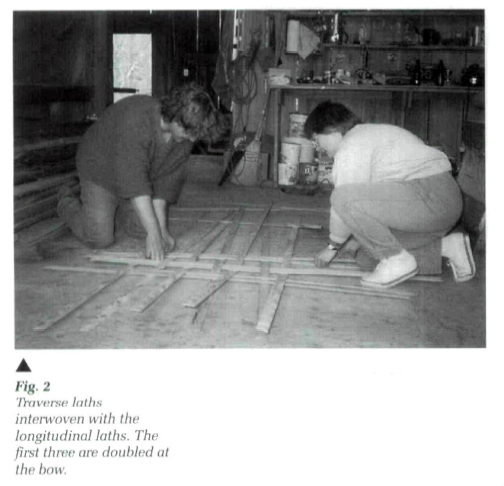 Display large image of Figure 2
Display large image of Figure 2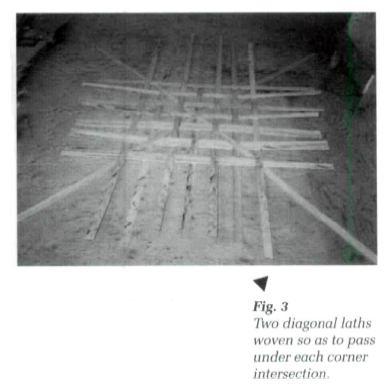 Display large image of Figure 3
Display large image of Figure 319 Although the Welsh rivers have produced specific types of coracles, according to differing environmental and traditional requirements, there is really no set design for coracles. Coracles are not cultural tokens, they are still developing and changing with their times. When, in the eighteenth century, textiles became much more easily obtained, there was a switch from the traditional hide covering of coracles to one of cloth. The earliest mention of this is to be found in Dr. Johnson's dictionary:
20 According to Hornell, this cloth was originally flannel; in about the 1870s it was switched to calico boiled in pitch or tar. This is obviously a major departure from tradition but, as Hornell points out, only one of several revolutions in method and materials. The most remarkable example is that of the replacement of the wooden frame, on the river Dee, with one made entirely of aluminum.7
21 In the construction of our first Teifi coracle, we used sawn ash laths (white ash instead of black), willow basketry, a pine (instead of a deal) seat, and canvas. These materials vary very little from those used on the Teifi, except in strength and thickness: both our canvas and our laths were thicker than the norm. This change was made to make the craft more durable. The LaPeche river has many sets of small rapids and is quite full of trees because of beavers (a creature long extinct in Wales). These changes caused us to have to change our method of construction: the thicker laths required boiling water to be poured on each one as it was bent up. Because of this change, we were unable to wattle the gunnel as we went, and had to employ a great many strings to hold both the transverse and the longitudinal laths. We also exchanged pitch and tar for paint, since the relatively much warmer Canadian summers made the traditional waterproofing too messy. The technical instructions we used were based on James Hornell's account in Water Transport: Its Origins and Evolution.8
22 The actual procedure that we followed began with the milling of an ash plank into laths. The rough plank, in this case a 5 cm by 25 cm by 3 m, must first be ripped, perpendicular to the grain, into four equal sections. These sections are then inverted 90 degrees so that the laths can be cut parallel to the grain. Although only 19 laths are actually needed for the Teifi coracle, it is prudent to rip several extra, in case of breakage during bending. Figure 1, showing the table saw, illustrates the crucial step of inversion during milling. If this step is not taken the ash will not bend, as the grain will run across the lath instead of along it.
23 Once the laths are ripped they can then be trimmed to length. Seven longitudinal laths are required, and they should be trimmed to about 2 m in length (the final trimming will take place only after the laths are bent and wattled). The transverse laths, being ten in number, should be cut to about 1.5 m. It should be noted that, if a 3-m long board is used in the milling process, two transverse laths are obtainable from a single length. Two diagonals will also be needed. They should be left at the full 3-m length.
24 The seven longitudinal laths are first laid out on the floor, or ground, at a spacing of about 10 cm. The ten transverse laths are then woven into the longitudinals so that 10-cm squares are formed. The weaving process requires two people: one to push the transverse lath through, and the other to force the end of it alternately over and under the longitudinal laths. This can be seen in Figure 2. Also, the transverse laths should alternate between passing over and under the outermost longitudinal lath. The first three rows, from the bow, are doubled to reinforce the front section of the craft, where one will eventually be placing one's feet. The next step is the insertion of the two diagonal laths. They must cross at the center of the grid, and it is important that they pass under each corner, so that when they are bent up they form the reinforcing base of each corner. The final phase is to square everything up. Using a wooden mallet, the symmetry of the grid squares can be quite easily achieved. The finished grid is shown in Figure 3. It should be tight and hold its form even if picked up and hung on a wall for example.
25 The seat is made of two pieces of pine, one about 83 cm long, by 20 cm wide, by 2.5 cm thick, and the other 75 cm long, by 2.5 cm square. These two pieces are joined by seven dowels, about 25 cm long and 1.25 cm in diameter. Pine is a good wood to use because it is relatively light and easy to work with.
26 Before joining the seat parts together, eight holes must be cut into the largest piece. At either end of the plank, two slots should be made. They should be wide enough to accept a lath, as one transverse lath will pass through each. It will make for much easier insertion of the lath if the trouble to cut the slot on a diagonal is taken: the diagonal being such that the entrance of the slot, on the bottom of the seat plank, is 1 cm closer to the end of the plank, than the exit on the top. The slots should be 10 cm apart on the inside corners, since the laths are all 10 cm apart, and in from the end about 4 cm. If the slots are cut too close to the end of the plank there is a definite risk of splitting off the end piece. The slots can quite easily be made by first drilling (at an angle to allow for the diagonal) a hole at each end of each slot. A jig-saw blade can then be inserted, and the holes connected. The drill bit should be a slightly larger diameter than the thickness of the lath (about 0.5 cm). The other four holes are straight drilled ones. Using a still larger bit, approximately 1 cm, two holes on each half of the plank should be made, one parallel to the back slot, and about 10 cm from the end of the plank, and the other parallel to the front slot, but about 20 cm in from the end. The positioning of these holes can be seen in Figure 4.
27 It is much easier to make the holes in the seat before it is joined to its other parts. The joining is done by drilling seven holes, 10 cm apart, in both the top and bottom pieces of the seat. They should be drilled in the center of the square lower piece, and about 5 cm in from the back edge of the upper piece (the seat plank). The holes are not drilled through though; they should only go in about half the thickness of the pieces. The bit diameter should be smaller than that of the dowels. The dowels should be tapered at each end with a knife, so that they wedge into the holes tightly. Having assured a good fit, i.e., that each dowel is perpendicular to the seat plank, and that each penetrates to the same depth, waterproof glue is put in the holes and everything is clamped together and left to set. Figure 4 shows the seat pieces just before gluing.
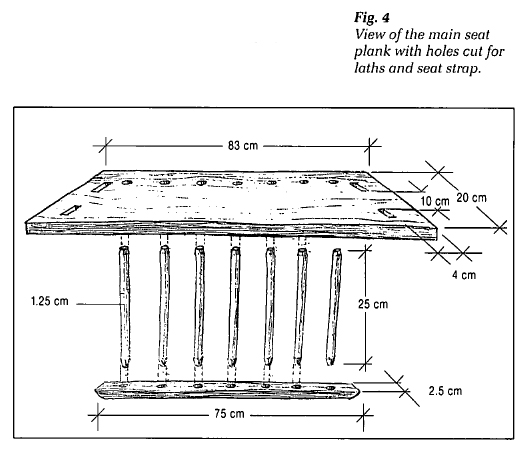 Display large image of Figure 4
Display large image of Figure 428 Once the seat is set, it is ready to be installed on the grid of laths. This is done by passing the second and third transverse laths, from the aft end, through the slots on either side of the seal plank. This stage, however, is truly easier said than done. It is advisable to have two people on hand for this stage. Each end of the two laths concerned is bent up, using boiling water from a kettle, and tied to its opposite. Some patience and practice is needed to perfect the ability to bend the laths consistently in the same arc. If the arcs are different on the two ends of the lath, the more acute arc will dominate, causing the lath to be too close on one side and too far on the other. Having secured both laths, the seat can then be carefully lowered into place. The laths must all pass through the slots at roughly the same time so as to avoid torsion or any one lath end. The strings that connect each end of the laths to each other are pushed down as the seat goes on. Once the laths are through all the slots, the strings can be cut and removed.
29 With the seat in place, rocks are put at the principle points of intersection. A rock in the middle of the seat is also a good idea, as it ensures that everything will stay in place. The rocks are used to keep the bottom of the boat flat when the laths are being bent up. A rock at each corner should suffice. The placement and the installed seat can be seen in Figure 5.
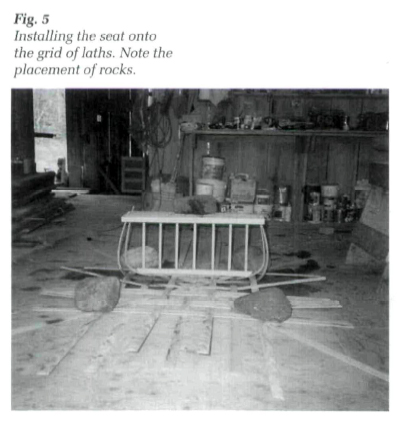 Display large image of Figure 5
Display large image of Figure 5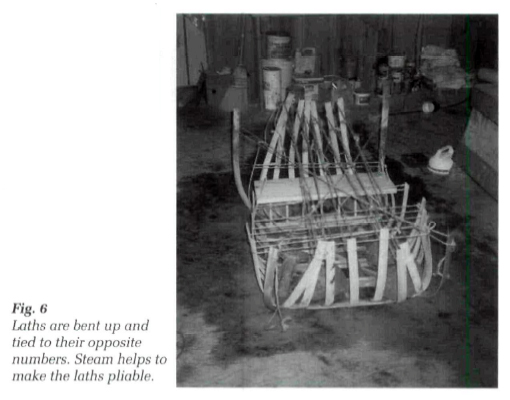 Display large image of Figure 6
Display large image of Figure 630 All the remaining laths can then be bent up and tied off to their corresponding ends. It is best to work from the front of the seat, alternating from side to side to facilitate tying, to the two front diagonals. The waist of the craft is at the seat, and care should be taken to let the sides come out a bit wider with each lath, until the diagonal is reached. The same is true of the one transverse lath behind the seat. Having bent all the transverse laths, the front is tackled. In the same manner, the ends of each lath are tied to each other. The bow laths should be bent with a degree of tumblehome (meaning that the arc exceeds 90 degrees). This is the most difficult stage of the whole operation, because the laths are required to bend so much that they often snap under the pressure. Lastly, the diagonals are bent and the ends tied to each other.
31 If a lath should break during this stage, all is not lost! The uncooperative piece can be gingerly removed from its place in the grid. Before removing it, however, the replacement lath should be inserted directly beside it. It is much easier to do it this way, as the perpendicular opposite laths are already held in place going over and under. Furthermore, the removal of the broken lath is made easy by shoving the new one closer to the next grid section, thereby causing a slackening in the overall tension of the grid at that particular point.
32 Figure 6 depicts the tied skeleton of the coracle. It can quite happily remain at this stage for some time. It is perhaps wise to leave it tied overnight at least, so that the bends will be "remembered" more readily by the laths when, in the next stage, the strings are removed.
33 For the next stage, wattling the gunnel, willow shoots are needed. They should be as long and slender as possible (in Wales, hazel withies are used). Generally, they can be found about 2 m long, with a basal diameter of 1 cm, running to a top diameter of 0.3 cm. About 30 should be gathered. The best time to gather is in the late winter or late fall, when the sap is down. They should be put to soak for three days immediately after culling. Once removed from the water, they should be stored vertically, butt down. They will retain their necessary pliancy for a season or so, if treated in this manner.
34 The willow is woven around the ends of the bent-up laths, after the fashion of basketry. Beginning on one side of the seat, the willows are crossed between the two seat laths, directly underneath the seat. They are then crossed again between each lath (the three sets of double laths are treated as if they were one lath each), so as to secure the lath firmly between them. The strings are removed as necessary. Ideally, the willows would reach all the way around to the other seat underside, but, realistically, one can expect to make it about three quarters of the way. When this occurs, simply move back one or two intersections of willow, and start anew with two more. Do not use one of the pair with the narrow end first and the other with the thick end. Always start with both thick ends, so as to ensure maximum strength at the point where the last two were weakest.
35 There are three rows of basketry. The first, from under the seat, as mentioned, around the front and back to under the other side of the seat. Upon reaching the underside of the seat, the willows go down to the bottom of the craft, forming a strengthening band, which comes back up to connect with where the willows first started. The band is an arc, which is about 30 cm away from the last transverse lath at its apex. The second row begins in the same place and manner, the only difference from the first being that, having gone around the front and back to the seat, it continues at the same level, forming the gunnel at the stern. The third row begins on top of the seat at one or other side (the laths should protrude through the seat enough to give the willows purchase). This last row goes all the way around the top level of the newly formed gunnel. Once again, it is advisable to have two participants in this stage; one to hold the lath in place, and the other to grab it between the willows.
36 At this point, the frame is essentially finished, and the rocks can be removed. As one can see in Figure 7, the ends of the laths exceed the height of the gunnel by about 5 cm in the front and 10 or 12 cm at the back. The laths should be trimmed, using a hand saw, to the level of the gunnel. Any final adjustments of the laths or the wattling should then be made.
37 Leaving the coracle right side up, it is placed on top of the "skin" or covering. Canvas or linen can be used. The covering is then folded around the sides and into the boat. Trimmed roughly to size along the gunnel, it is then ready to be sewn. The material is folded over, so that it might be sewn in a straight line parallel to the gunnel; 14 kg test kite string is the type of strength of thread needed. The thread is sewn directly through the willow gunnel, and thru passes back over the top of gunnel for the next pass. The stitches should be about 1 cm long at most, and it is preferable to make two rounds — one in each direction. If two people sew at once, they should place themselves opposite one another in order to stretch against each other's sewing as they go. It is important to stretch the material quite tight, and the corners should be rounded with several pleats each. In Figure 8 one can see the sewing just beginning. It is not important where one starts sewing.
38 The outer shell must then be waterproofed. Marine paint, porch enamel, and metal paint all work well. The first coat is thinned considerably, allowing the paint to penetrate the material completely, thereby coloring the inside of the craft, as well as protecting it. Five or six more coats should follow, with a day between each for drying.
39 The leather carrying strap is threaded through the two innermost holes of the seat and then back up through the outermost two. Knots are tied to secure it. The strap should have enough slack that it fits comfortably around the shoulders (Fig. 9).
40 The coracle now being finished, all that remains is the means of propulsion. The paddle should be made of ash. Just over 1 m long, it has a hook, or claw, at the top. This claw is used to hook under the basal bar of the seat, to make carrying the coracle easier. The paddle face itself is 45 cm long by 10 cm wide. It has a flat face and a convex back. The shaft is oval and about 4 cm in diameter. When one is carrying the coracle, the paddle should pass over one shoulder and under the seat. Purchase can then be gained by using the shoulder as a fulcrum, pulling down on the front of the paddle.
41 With the boat perched on your back in this manner, you are now ready to walk to the nearest river and launch it. Getting in can at first be a little awkward, but this manœuvre, like the boat, is soon mastered. Once you have worked out how to go straight rather than in circles, you are ready to enjoy this ancient and practical little boat.
